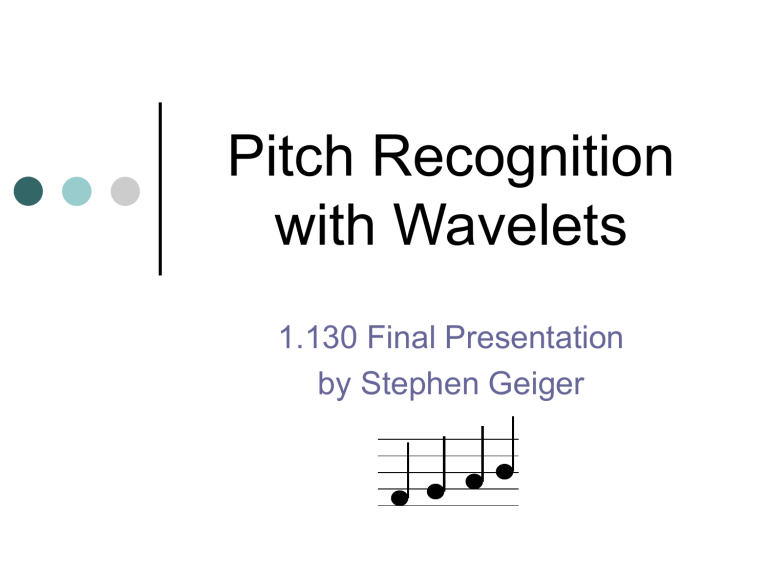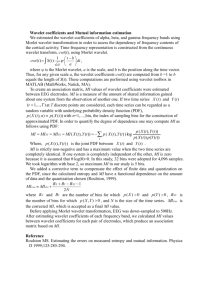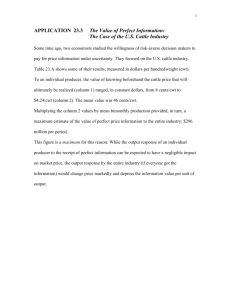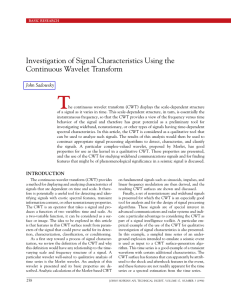Pitch Recognition with Wavelets

Pitch Recognition with Wavelets
1.130 Final Presentation by Stephen Geiger
What is pitch recognition?
Well, what is pitch? . . .
How HIGH or LOW a sound is
Which note?
Perceived Frequency
Relationship Between
Pitch and Frequency
Pitch
Fundamental
Frequency
For Example:
For Middle C:
Frequency = 262 Hz
MATLAB CODE: fs = 22050; % Sampling Frequency.
f = 262; % Fundamental Freq of Middle C. t=0:1/(fs):1; % Time range of 0 to 1 seconds. sound(cos(2*pi*f*t)/2,fs); % Make some noise!
For an A Scale:
A = 220*2^( 0 /12)= 220 Hz
A#= 220*2^( 1 /12)= 233 Hz
B = 220*2^( 2 /12)= 247 Hz
C = 220*2^( 3 /12)= 262 Hz
C#= 220*2^( 4 /12)= 277 Hz
D = 220*2^( 5 /12)= 294 Hz
D#= 220*2^( 6 /12)= 311 Hz
E = 220*2^( 7 /12) = 330 Hz
F = 220*2^( 8 /12) = 349 Hz
F#= 220*2^( 9 /12) = 370 Hz
G = 220*2^( 10 /12)= 392 Hz
G = 220*2^( 11 /12)= 415 Hz
A = 220*2^( 12 /12)= 440 Hz
An Octave Up:
For C5:
Frequency = 524 Hz
MATLAB CODE: fs = 22050; % Sampling Frequency.
f = 524; % Fundamental Freq of C5.
t=0:1/(fs):1; % Time range of 0 to 1 seconds. sound(cos(2*pi*f*t)/2,fs); % Make some noise!
A Sum with 2 Frequencies:
Frequency = 262 Hz and
Frequency = 524 Hz
MATLAB CODE: fs = 22050; % Sampling Frequency.
f1 = 262; % Fundamental Freq of Middle C. f2 = 524; % Fundamental Freq of C5.
t=0:1/(fs):1; % Time range of 0 to 1 seconds. sound((cos(2*pi*f1*t)+ . . .
0.25*cos(2*pi*f2*t))/2,fs);
Freq in a Piano - Middle C
Frequency, Hz
FFT of a Oboe Middle C
Frequency, Hz
Mono vs. Poly
Monophonic
one note at a time
(e.g. trumpet)
Polyphonic
multiple notes at a time
(e.g. piano, orchestra)
Creates a problem for pitch recognition.
(especially octaves!)
Some Existing Methods
Time Domain – Pitch Period estimation
With wavelets.
With auto-correlation function.
Freq. Domain – Find Fundamental
Auditory Scene Analysis
Blackboard Systems
Neural Networks
Perceptual Models
What applications are there?
Transcription of Music
Modeling of Musical Instruments
Speech Analysis
Besides its an Interesting Problem
My Work . . .
A Novel Wavelet Approach
Based on an observation made by
Jeremy Todd, that:
For a piano playing these notes , a CWT could be used to identify a ‘G’ with certain scale/wavelet combinations.
Even with some polyphony !
Finding a G in a C Scale
Original
Signal
CWT @
Specific
“Scale”
The Continuous Wavelet
Transform
Definition of a CWT:
C a , b
f ( t )
1 a
a b dt
Where: a = scaling factor b = shift factor f(t) = function we start with
(t) = Mother wavelet
What is Scale?
LOW SCALE
Compressed Wavelet
Lots of Detail
High Frequency
HIGH SCALE
Stretched Wavelet
Coarse Features
Low Frequency
(You are here) (And here)
Gaussian 2 nd Order Wavelet
Initial Work
Took an empirical approach.
Ran a number of CWT’s at varying scale, and looked at the results.
Picked out a CWT scale for each note in the C scale.
Finding Notes in a C Scale
Original
Scale: 594
530
472
446
394
722
642
606
Finding Notes w/ Polyphony
Original
Scale: 594
530
472
446
394
722
642
606
More Complex Polyphony
Original
Scale: 594
530
472
446
394
722
642
606
Testing with different timbre
Original
Scale: 594
530
472
446
394
722
642
606
Why does this work?
The scale parameter in the CWT affects frequency response.
However, our “scales” that work don’t seem to follow a clear pattern.
Training Algorithm
Again, took an empirical approach.
Ran CWT’s at varying scales, on sample files containing one note.
Picked out scales, where: maximum of the CWT for one note >> other notes
(and collected results).
Results of
Training Algorithm
. . .
Longer C Scale –
Trained on 3 Octaves of Notes
*From Right Hand of Prelude in C, Op. 28 No. 1
A Fragment by Chopin*
Training on a ‘Real’ Guitar
Only able to find 5 of 8 pitches for C Scale training case. (With limited attempt).
Results on a test file were not completely accurate.
Expected to be a more difficult case than a piano.
Could merit a more thorough try.
Entire 88 K on a P
Work in progress.
It takes a long time to run many
CWT’s on 88 different sound files.
Initial results able to identify notes 70-88.
Frequency Response
Revisited
Frequency Response of a 2 nd Order Gaussian Wavelet
2500
Resulting Scales for
22 Piano Notes
2000
SCALE
1500
1000
500
0
0 1 2 3 4 5 6 7 10 11 12 13 14 15 16 17 18 19 20 21 22 8 9
NOTE NUMBER
10000
SCALE 8000
6000
4000
2000
0
0
Resulting Scales for
8 Sinusoidal Notes
14000
12000
1 2 3 4
NOTE NUMBER
5 6 7 8
Conclusions
The novel wavelet approach isn’t perfect.
Requiring “training” is a handicap.
Most likely not suited to sources with varying timbre. (e.g. guitar, voice)
Some interesting results.
The mechanism of detection could be further investigated and better understood.







